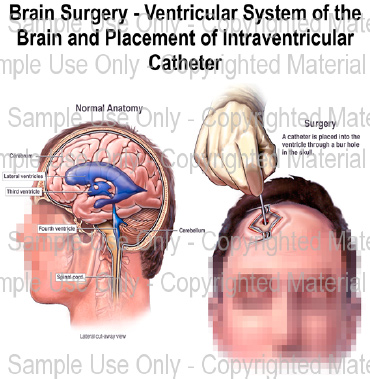What is a insertion of external ventricular drain?
External Ventricular Drains are inserted for the management of too much fluid or increased pressure on the brain.
The procedure involves a small cut being made about 10cm above the eyebrow usually on the top right hand side of the head. A small hole is drilled into the skull beneath the cut and the firm covering of the brain is opened.
A small plastic tube (drain) is passed into the fluid spaces of the brain and stitched in place. The drain is connected to a drainage collection bag to collect the fluid from the brain. The drain will stay in place until the excess fluid is managed or other treatment options are discussed.
The cut is closed with sutures or clips.
My Anaesthetic
This procedure will require a General Anaesthetic.
See About your Anaesthetic information sheet for information about the anaesthetic and the risks involved. If you have any concerns, talk these over with your doctor.
If you have not been given an information sheet, please ask for one.
What are the risks of this specific procedure?
There are some risks/complications with this procedure.
Common risks include:
- Infection. This may need antibiotics and further treatment.
- Minor pain, bruising and/or infection from IV cannula site. This may require treatment with antibiotics.
- Bleeding. A return to the operating room for further surgery may be required if bleeding occurs. Bleeding is more common if you have been taking blood thinning drugs such as Warfarin, Asprin, Clopidogrel (Plavix or Iscover) or Dipyridamole (Persantin or Asasantin).
Uncommon risks include:
- A heart attack because of the strain on the heart.
- Stroke like complications which can cause weakness in the face, arms and/or legs. This may be temporary or permanent.
- Fluid leakage from around the brain can occur after the operation. This may require further surgery.
The drain may need to be replaced in the future with a more permanent diversion procedure.
- Epilepsy which may require medication. This condition may be temporary or permanent.
- Small areas of the lung may collapse, increasing the risk of chest infection. This may need antibiotics and physiotherapy.
- Increase risk in obese people of wound infection, chest infection, heart and lung complications, and thrombosis.
- Clots in the leg (deep vein thrombosis or DVT) with pain and swelling. Rarely part of this clot may break off and go into the lungs.
Rare risks include:
- Injury to the brain, important nerves or blood vessels. This can lead to stroke like complications which can cause weakness in the face, arms and/or legs.
- Death is rare due to this procedure.


 Appointments
Appointments